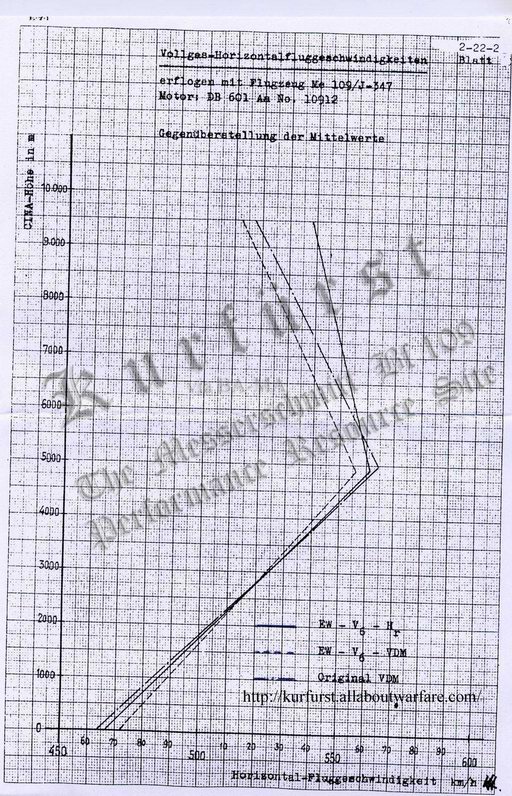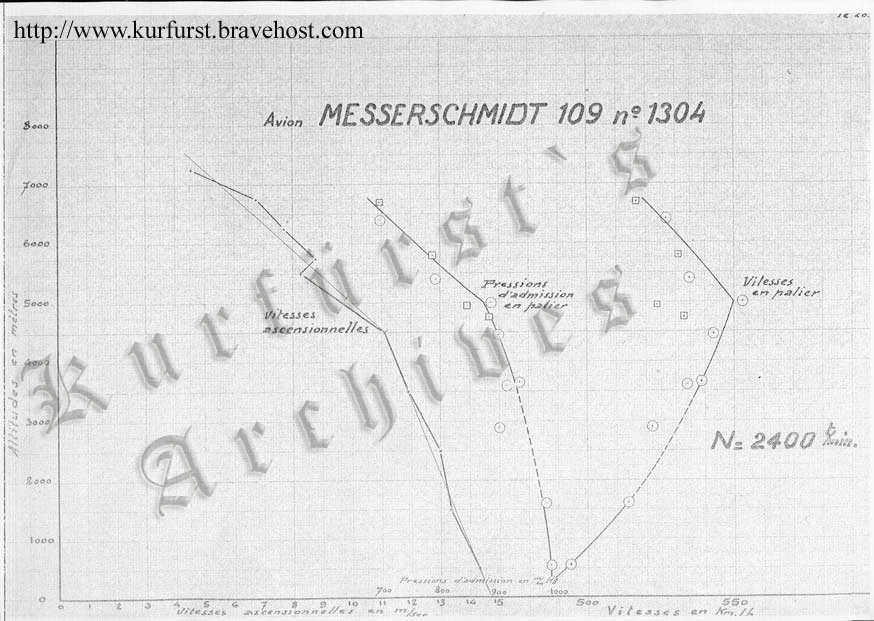
 |
|
|
|
#1
|
||||
|
||||
|
Quote:
|
|
#2
|
||||
|
||||
|
Quote:
It was discovered when the Luftwaffe was rejecting a large number of aircraft. The complaint was excessive vibration and fuel consumption. It generated several reports on the issue and was fixed promptly. It caused NDW to suffer greatly increased oversight and they almost lost their contract. |
|
#3
|
||||
|
||||
|
Quote:
|
|
#4
|
||||
|
||||
|
There were 2 types of engines used by LW - Db601A and DB601Aa which had little different power output.
Db 601A - sea level 1 minut emergency (2400 RPM at 1.4 Ata) - 1100 PS 5 minut emergency (2400 RPM at 1.3 Ata) - 990 PS Db601Aa - sea level 1 minut emergency (2500 RPM at 1.45 Ata) - 1175 PS 5 minut emergency (2400 RPM at 1.35 Ata) - 1015 PS Standart 109 E-3 with Db601 at 1.3 Ata 2400 RPM (5 minut power) reached at sea level - 467 km/h ( radiator 1/4 open)  http://kurfurst.org/Performance_test...MP16feb39.html It is good agreement with Swiss 109 E-3 Db601Aa tested with different propellers:  Sea level speed - 467 km/h with standart propeller Quite close with tested captured 109 E-3 by French :  So it could be that with Db601 Aa at 1.45 Ata 2500 RPM (radiator close?) - 1 minut emergency power 109 E-3 reached 500 km/h like in German manual:  Interesting is that at low level 109 E-3 need 5-minut power output with speed 467 km/h comparing to Spitfire MK1 at 6 1/2 lbs ( 1/2 hour limit) - 455 km/h. Db 601A had 990 HP at 1.3 Ata where Merlin III had 880 HP at 6 1/2 lbs at sea level. Last edited by Kwiatek; 10-26-2011 at 10:35 AM. |
|
#5
|
||||
|
||||
|
Quote:
As it is labeled, it is what the manufacturer guaranteed and what was accepted by the customer. Quote:
A newly manufactured aircraft is one of the most dangerous things in aviation. It is unproven. A very thorough inspection is completed before the first test flight. The manufacturer will put the aircraft thru a test flight period to ensure it reaches its numbers before turning it over to the customer who again goes thru their own prescribed regiment of test/inspections before accepting it. When an airframe reaches the end of the assembly line, it was not uncommon for it to remain there for a month or so as it was tweaked and refined before being accepted. Quote:
Last edited by Crumpp; 10-26-2011 at 11:24 AM. |
|
#6
|
||||
|
||||
|
Quote:
I really don't think development was static in Germany for 18 months before the Battle the Britain. Otherwise we would have to believe that Germany exported more powerful engines than they used in their own aircraft. That does not make any sense and would be a first in the history of the world. We don't know the exact conditions, perhaps it is the performance with the automatik propeller? |
|
#7
|
||||
|
||||
|
Quote:
Again - 500 +- 5% means they tried to achieve 500 but it was more likely that most of the time, they made it closer to the -5% in so called real life. I am not saying that they were failing to stay within margins. Quote:
Quote:
|
|
#8
|
|||
|
|||
|
You all realize that the French test obtained about 494 kph at 600m altitude and in extrapolating to 0m something around 480 kph? At rpm = 2400.
The pression d'admission about 1000 (unit I cannot read). My guess is that they speak here of ATA pressure. Just not sure what kind of unit they used as I cannot decypher the scale label. Last edited by 41Sqn_Stormcrow; 10-26-2011 at 01:21 PM. |
|
#9
|
||||
|
||||
|
Here is French 109 test raport :
http://kurfurst.org/Performance_test...formanceT.html We got from French test : With radiator open 2.5 km - 490 km/h - 2400 RPM - 960 mm. ( 1.3 Ata) 5.0 km - 520 km/h - 2400 RPM - 870 mm. With radiator close: 5.0 km - 570 km/h - 2400 RPM - 880 mm. There is 50 km/h difference between radiator open and close at 5 km alt. In chart there is about 475-480 km/h at 2400 RPM at 1000 mmHg which mean that test was done at ab. 1.35 Ata - probably radiator somewhere in the middle position (looking at 5 km maxiumum speed - 550 km/h) so with higher ATA then in previous data ( 1.3 Ata - 460-467 km/h). So it confirmed previous data for E-3 1.3 Ata 0- 460-467 km/h - depend of radiator settngs, and sort of plane 1.4 Ata (Db601A) - about 485-490 km/h 1.45 Ata (Db601Aa) - 500 km/h. 109 E-4 would be little slowier then E-3 beacuse of more draggy windscreen - it could be about 5 km/h slowier ( the same E-3 with new windscreen) Last edited by Kwiatek; 10-26-2011 at 02:13 PM. |
|
#10
|
|||
|
|||
|
The chart has at 600m a pressure of 980 mmHg pression d'admission. Extrapolating it would be at 990 mmHg at 0m. The speed is clearly close to the 480 kph when extrapolating the chart to 0m, perhaps at worst 478 kph.
5 kph velocity loss seems a bit extensive with respect to the new windscreen. They even did not measure any difference with guns installed or not (so including the effect that for level flight higher angle of attack would have to be chosen due to increased weight of the guns). Pression d'admission translates into inlet pressure or manifold pressure so I think this is ATA setting they used. http://dictionary.reverso.net/french...'admission Last edited by 41Sqn_Stormcrow; 10-26-2011 at 02:32 PM. |
 |
|
|